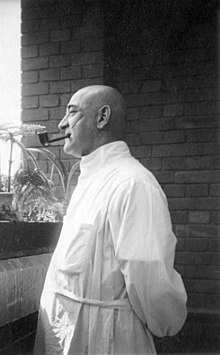Walter Mirauer
Walter Mirauer (born November 16, 1882 in Berlin ; † March 17, 1948 there ) was a German surgeon and gynecologist .
At several sites in Germany, he paid particular attention to accident surgery victims and extension in the case of broken bones. Mirauer also campaigned for the establishment of a nationwide blood bank . As a Jew, Mirauer was subject to restrictions on his work between 1933 and 1945.
Life
After Elisabeth and before Fritz, Walter Daniel Mirauer was the second child of Carl and Zerline Mirauer (née Kraft), who married on May 25, 1880 in the synagogue on Oranienburger Strasse in Berlin-Mitte . Mirauer attended the renowned French grammar school and then the Wilhelms grammar school in Berlin. After school he went to Munich to study medicine, but returned to his hometown in 1907 for a doctorate at the Friedrich-Wilhelms-Universität. From 1908 Mirauer was an intern at the municipal hospital Gitschiner Strasse in Berlin-Kreuzberg for four years. On November 11, 1912 he married Ilka Kwasniewski, daughter of the married couple Johann Kwasniewski and Clara von Grumbkow.
After short professional intermezzi at the Berlin Charité with the gynecologist and surgeon Max Stickel and the university gynecological clinic in Halle / Saale , Walter Mirauer practiced as a gynecologist in his own practice in Mannheim in 1913/14 . However, since he was mainly interested in surgery, he took advantage of the opportunity and worked at the municipal hospital in Berlin-Schöneberg from 1914 to the end of 1916 , among others together with the surgeon Ernst Unger . During this time the sons Helmuth (born November 7, 1914) and Günther (born January 13, 1916) were born.
From the beginning of 1917 to 1921 Walter Mirauer was chief physician at the district hospital in Salzwedel , interrupted only by his time as a war assistant and hospital manager on the western front from 1917 to early 1919. Mirauer was awarded the Iron Cross . The children Ursula (* September 22, 1917) and Klaus (* November 21, 1919) were born in Salzwedel. In 1921 Mirauer opened a private clinic in Staßfurt and practiced as a gynecologist and surgeon himself, before he was appointed chief physician at the municipal hospital in Calbe (Saale) in 1925 . During the time of National Socialism, he was initially protected by his profound skills and his services in the First World War, but when the so-called Nuremberg Laws came into force , he had to give up his work in Calbe. He returned to Berlin and worked in a doctor's practice in Charlottenburg, but was only allowed to do so because he was married to a non-Jewish woman and had children with her. Besides Günther, the children left Germany in 1938 and fled to Great Britain; Ursula moved to the Netherlands after her marriage.
In 1942 Walter Mirauer was asked by the Gestapo to take over the surgical department of the Jewish hospital in Berlin-Gesundbrunnen . Mirauer thus succeeded Ernst Eylenburg . About 800 people experienced the liberation with Mirauer in the Jewish hospital, including his son Günther, who served as a half-Jew in the Wehrmacht and was sick with typhus on the Eastern Front. In September 1945 Walter Mirauer was entrusted with the management of the surgical department of the municipal Rudolf Virchow hospital in Berlin and after much effort was able to resume operations in the badly destroyed hospital. Mirauer died of a heart attack.
font
Mirauer: About the cutaneous tuberculin reaction, especially the results of vaccinations with graduated tuberculin concentrations , Verlag Curt Kabitzsch, 1910
literature
- Rivka Elkin: The Jewish Hospital in Berlin between 1938 and 1945 , Series German Past Volume 77, Verlag Hentrich, 1993, ISBN 3-89468-049-0
Web links
Individual evidence
- ^ The situation reports of the secret state police for the province of Saxony 1933 to 1936: administrative region Magdeburg . In: Hermann-Josef Rupieper, Alexander Sperk (Hrsg.): The situation reports of the secret state police for the province of Saxony 1933 to 1936 . tape 1 . mdv, Mitteldeutscher Verlag, Halle 2003, ISBN 3-89812-200-X , p. 220, 476 (487 p., Limited preview in Google Book search).
| personal data | |
|---|---|
| SURNAME | Mirauer, Walter |
| BRIEF DESCRIPTION | German surgeon and gynecologist |
| DATE OF BIRTH | November 16, 1882 |
| PLACE OF BIRTH | Berlin |
| DATE OF DEATH | March 17, 1948 |
| Place of death | Berlin |
